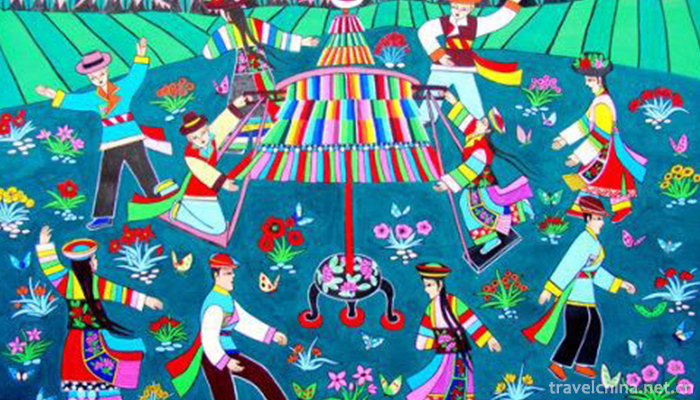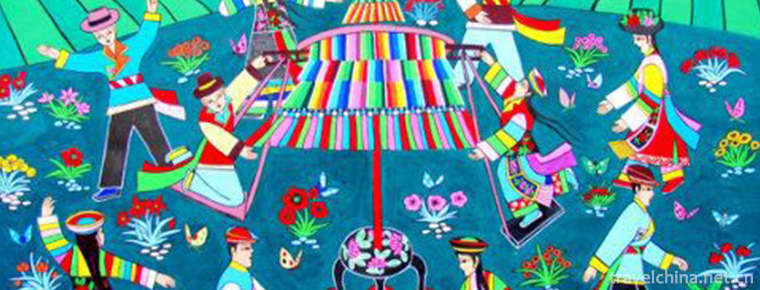Turkish Pan Embroidery
Turkish Pan Embroidery
Tu Pan Embroidery, a traditional Tu folk art in Huzhu County, Qinghai Province, is one of the national intangible cultural heritages.
Pan embroidery is the most important embroidery method in Chinese Tu embroidery, and it is a compulsory course for Tu women in their lifetime. Pan embroidery is a unique embroidery method of the Tu nationality, which is complex and ingenious and contains the profound connotation of the ancient Tu culture. In the eastern mountainous area of Qinghai Plateau, industrious and simple Tu women have inherited the ancient traditional national embroidery art from generation to generation. Their embroidery skills are exquisite, their workmanship is exquisite and skillful.
On May 20, 2006, the Turkish pan embroidery was approved by the State Council and listed in the first batch of national intangible cultural heritage list.
Historical Origin
In the Tuguhun tomb excavated in Dulan County, Qinghai Province, embroidery similar to pan embroidery was unearthed, from which we can see that Pan embroidery technology has appeared around the 4th century.
Li Faxiu, the representative inheritor of Tu pan embroidery, made innovations from various perspectives: in pattern design, incorporating the elements of the times and symbolic events, bringing fresh flavor to Tu pan embroidery; in category development, practical types such as sachets, purses and pendants are the main types, while the base material of Pan embroidery is changed from traditional black cotton cloth to brocade, making it more beautiful.
Cultural characteristics
Artistic Characteristics
Pan embroidery is silk embroidery, with red, yellow, green, blue, cinnamon, purple, white and other seven-color embroidery, embroidery is generally full of seven colors, color coordination, bright and dazzling. The design of Pan embroidery is ingenious and has a strong national style, including dozens of styles, such as Falun, Taijitu, Five-petal Plum, Immortal Queen, Moire, Rhombus, Sparrow Head, Fortune Head, Character, Buddha Statue, etc. The embroidery stitches of Tu nationality are delicate and distinct.
Production process
Disc embroidery material is exquisite, fine processing, with black cotton cloth as the base material, and then choose the fabric paste. The needle method of disc embroidery is very unique. When the needle is manipulated, two threads of the same color are used, one for disc thread and the other for sewing. Disk embroidery does not need a scaffold, but operates directly with both hands. The embroiderer holds the cloth in his left hand and the needle in his right hand. The thread for the diskette thread hangs on his right chest, and the thread for the suture thread goes through the eye of the needle. Upper needle tray, lower needle sewing, one needle and two threads, although labor and materials, but the finished product is thick and gorgeous, durable.
Subject works
Pan embroidery can be seen everywhere in Tu people's life. It involves headdress, collar, belt, pillow towel, needle tie and purse. The most common patterns are Babao, Caiyun, Taijitu, rich head, eight lotus petals and so on. The main works are Tu flower sleeve shirts (called "Xiusu" in Tu language)
Inheritance and Protection
Inheritance value
The Tu embroidery with a thousand-year history has been handed down till now, and its cultural and artistic value can not be underestimated. Turkish pan embroidery is colorful and lifelike in design. It reflects the aesthetic attitude and value judgment of the nation in shape, color, quality and meaning. It provides fresh materials for the study of Ethnology and aesthetics.
Turkish pan embroidery works show the extensive and exquisite folk culture and art of the Turkish people, and have high ornamental and collection value.
The Tu pan embroidery art is an important carrier of the Tu culture and a cultural product with distinct ethnic regional characteristics. It carries too much cultural information in the history of national change and is the material symbol of the spiritual cohesion of the whole Tu nationality.
Heritage figures
Li Faxiu, female, Tu nationality, born in 1959, is a native of Huzhu Tu Autonomous County, Qinghai Province. The first batch of national intangible cultural heritage projects are representative inheritors of Tu embroidery.
protective measures
Under the guidance of Qinghai University for Nationalities, Huzhu Tu Autonomous County of Qinghai Province set up three cooperatives of township enterprises for Tu embroidery, which helped sign an order of 90,000 yuan for Suzhou famous brand enterprises, benefiting more than 300 local Tu embroidery mothers.
Relying on Colleges and universities in and outside Qinghai Province, Qinghai has held 16 training courses for inheritors of national and provincial non-heritage projects, such as Tangka, Japanese stone carvings, Huangzhong silver and bronze wares, Huangzhong embroidery, Tu pan embroidery, Hehuang embroidery, Gologesar handicraft and so on, with a cumulative training of more than 900 people.
social influence
Important activities
During the 2008 Beijing Olympic Games, Li Faxiu participated in the exhibition of folk art "Chinese Stories" recommended by Qinghai Cultural Department. Since then, the "non-surviving flower" inheriting the emotions between Tu women and mothers has won many honors such as the Gold Prize of China Weaving and Embroidery Exhibition, and performed at the UN Women's Congress.
The Turkish pan embroidery works won the gold medal in the 2009 "Splendid China" China Weaving and Embroidery Exhibition.
In 2013, Tu embroidery participated in the 4th Chengdu International Intangible Cultural Heritage Festival of China, co-sponsored by the Ministry of Culture, the Sichuan Provincial Government, the National Committee of UNESCO of China and UNESCO.
On December 11, 2017, the intangible cultural heritage exhibition of the Marine Silk Road opened in Quanzhou, Fujian Province, the starting city of the ancient Marine Silk Road. On-site exhibitions of the splendid "non-relics" treasures on the "Haisi" road included the Tujia embroidery in Qinghai, the traditional embroidery techniques in Beijing, the Yangliu Youth Painting in Tianjin, and the Manchu paper-tearing skills in Changbaishan, Jilin Province. The style highlights the master craftsman's superb craftsmanship and ingenuity, conveying a strong regional characteristics and national customs.


-
1.Ailao Mountain
Ailao Mountain, located in the middle of Yunnan Province, China, extends south of Yunling Mountains. It is the boundary between Yunnan-Guizhou Plateau and Hengduan Mountains. It is also the watershed
Time 2018-11-01 -
2.Pavilion of Prince TengTengwang pavilion
Tengwang Pavilion, one of the three famous buildings in the south of the Yangtze River, is located on the East Bank of Ganjiang River along the Yangtze River Road in the northwest of Nanchang City, Ji
Time 2018-12-08 -
3.Xiantan Mountain Hot Spring Town
Xiantan Mountain Hot Spring Town is located in Xiwangzhuang Town, Zaozhuang City, Shandong Province. It is on the west side of Zaoji S345 Highway, south of Taierzhuang Ancient City, and on the side of
Time 2018-12-22 -
4.Random Bomb Luan tan
Random Bomb, a traditional drama in Taizhou and Pujiang counties of Zhejiang Province, is one of the national intangible cultural heritage.
Time 2019-05-15 -
5.Mongolian Boke
Boke is one of Mongolian traditional sports and recreational activities. People on the grassland call Mongolian wrestling "Boke" (strong, united and lasting meaning of Mongolian). It is the
Time 2019-06-03 -
6.Nanyin Rap
Nanyin rap is a form of rap sung in Guangzhou dialect. It is also a common melody in Cantonese opera and Cantonese opera. It is said that Nanyin rap was developed on the basis of wooden fish and drago
Time 2019-06-07 -
7.Saban Festival of the Tatar Nationality
The Saban Festival (also known as Ploughshare Festival) of the Tatar Nationality is a unique traditional festival of the Tatar Nationality. Every year, after the spring sowing of all the farmers in th
Time 2019-06-18 -
8.China West Normal University
Xihua Normal University is a key university in Sichuan Province. The school was founded in 1946 and began at the National Northeast University during the Anti-Japanese War. At the beginning of the Ant
Time 2019-08-31 -
9.Anhui University
( Anhui University For short, "anda" is located in the provincial capital. Market It's the state. "Double First-Class" initiative "World class discipline construction," M
Time 2019-10-04 -
10.Natural resources of Panzhihua
Panzhihua is rich in hydropower resources, with theoretical reserves of more than 6.879 million kilowatts and exploitable capacity of 5.994 million kilowatts. The distribution of hydropower resources in Panzhihua area is concentrated, mainly distributed in the Jinsha River and Yalong River, as well as the tributaries of Anning River, Yongxing River and Tengqiao river.
Time 2020-12-14 -
11.Nanchong medical and health
By the end of 2019, Nanchong has 8457 medical and health institutions (including village clinics), including 166 hospitals and 8250 primary medical and health institutions. The number of beds in medical and health institutions was 43726, an increase of 4.9% over 2018
Time 2020-12-17 -
12.Guangan bus
In the main urban area of Guang'an City, there are not only urban buses directly to Deng Xiaoping's hometown scenic spot, Shenlong mountain Ba Ren stone city, Siyuan square, but also one-day tour through bus to Huaying Mountain, baoz
Time 2020-12-19